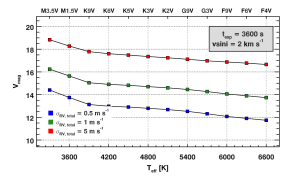The Keck Planet Finder Exposure Time and RV Precision Calculator simulates photon-limited uncertainties across a range of expected stellar and observational parameters. Synthetic stellar spectra (Allard et al., 2012) are scaled using modeled atmospheric and instrumental efficiency curves, remapped onto the KPF spectral format (including instrument resolution, sampling, blaze functions, echelle order distribution). Velocity uncertainties are then calculated on a per-pixel basis using the RV information content formalism of Bouchy et al. (2001) and Murphy et al. (2007). Read noise (assumed 3 electrons per pixel) from the CCD is included in the flux uncertainty. Final performance estimates are presented as a function of stellar spectral type, target brightness, and exposure time. Examples of plots and explorations possible with the calculator are shown below.
Download the KPF Exposure Time (and RV Precision) Calculator to further explore the capabilities of this upcoming next-generation instrument.


The KPF ETC is developed by Sam Halverson.
